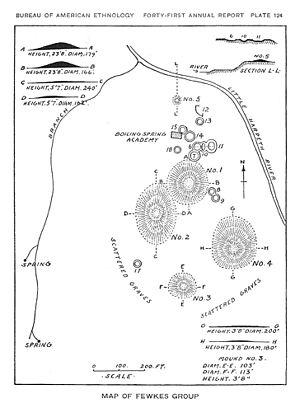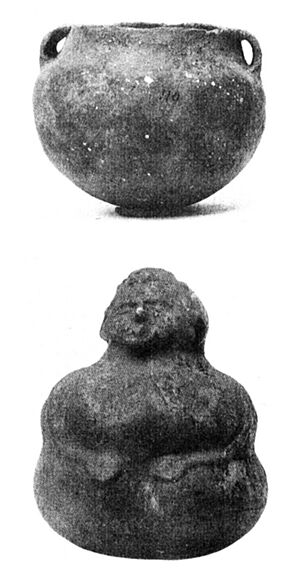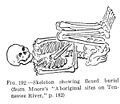Fewkes Group Archaeological Site facts for kids
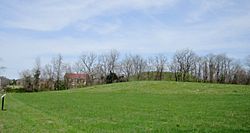
Fewkes Mounds No. 1 & 2. Boiling Spring Academy in the background
|
|
| Location | Williamson County, Tennessee, |
|---|---|
| Region | Williamson County, Tennessee |
| Coordinates | 35°58′0.44″N 86°46′34.54″W / 35.9667889°N 86.7762611°W |
| History | |
| Founded | 1050 |
| Abandoned | 1475 |
| Cultures | Mississippian culture |
| Site notes | |
| Excavation dates | 1920 |
| Archaeologists | William E. Myer |
| Architecture | |
| Architectural styles | burial mounds, platform mounds, plaza |
| Responsible body: City of Brentwood | |
The Fewkes Group Archaeological Site (also known as the Boiling Springs Site) is a very old Native American site in Brentwood, Tennessee. It's part of Primm Historic Park, near the Boiling Spring Academy, a school built in 1830. This 15-acre site holds the remains of a large village and mound complex.
These structures were built by the Mississippian culture people. They lived here between about 1050 and 1475 AD. The site is on the western bank of the Little Harpeth River. It has five mounds, some used for burial and others for ceremonies. The village was left empty around 1450 for reasons still unknown.
The site is named after J. Walter Fewkes, a leader of the Bureau of American Ethnology in 1920. He visited the site and saw how important it was. The land owner did some digging in 1895. Later, archaeologist William E. Myer led a more complete excavation in October 1920. Many items found here are now at the Smithsonian Institution. The site became a protected historic place on April 21, 1980.
Contents
Who Lived at the Fewkes Site?
Two different groups of people lived at the Fewkes Site over time. The first group built the mounds and left most of the artifacts. They buried their dead in special stone box graves. These graves were shaped like hexagons or circles. The bodies were often tightly bent, possibly tied after death. These people likely lived in round houses. This period was during the Mississippian era, from 1000 to 1450 AD.
A second group moved into the area later. They buried their dead lying flat on their backs. Their stone box graves were rectangular. Around 1450, people seemed to leave this area of the Middle Cumberland River Valley. We don't know why they left. Many broken pots were found in their homes, which might mean they left quickly. This leaving of a large area is called the "Vacant Quarter" hypothesis. It happened in parts of the Ohio, Mississippi, Tennessee, and Cumberland River valleys. As of 2010, experts have not found modern tribal groups directly linked to the people who lived here.
Exploring the Fewkes Site Layout
The Fewkes site has five mounds. Four mounds are around a flat town plaza. The fifth and smallest mound is by the river, north of Mound No. 1. Today, the Boiling Spring Schoolhouse stands between Mound No. 1 and Mound No. 5. Mound No. 1 is the biggest, standing about 25 feet (7.6 meters) tall.
Archaeologists found traces of about a dozen circular houses. These were mostly between Mound No. 1 and Mound No. 5. The most important houses were next to Mound No. 1. A stone box cemetery was also found nearby.
Mound No. 1: The Tallest Mound
Mound No. 1 is the largest mound at the site. It is on the northern side of the town square. This platform mound is 25 feet (7.6 meters) high. It measures 185 feet (56 meters) by 160 feet (49 meters) across. In 1920, it was not fully dug up due to lack of money. Archaeologist William Myer thought it was used for ceremonies. It might have also been where a chief lived.
Mound No. 2: A Mound of Many Layers
Mound No. 2 is on the western side of the plaza. It is 235 feet (72 meters) from north to south and 160 feet (49 meters) from east to west. When it was dug up, it was about 7.5 feet (2.3 meters) high. Less than one-fifth of the mound was excavated. So, we don't know how many buildings were on it.
The mound was built in four stages. The first level was the original ground. Here, archaeologists found a fire pit with ashes and animal bones. This shows a building was there before the mound was built. After that building was removed, a 3-foot (0.9-meter) high mound was built.
On the second level, there was evidence of at least one building. Its floor was packed down and covered with stone slabs, like pavement. A small pile of maize (corn) was also found. In one part of the mound, the ruins of a "Sacred Image House" were found. It had a sacred idol and signs of fire ceremonies.
After these buildings were removed, the mound was made a few inches taller for the third stage. Many items were found here, like grinding stones, arrowheads, and pottery. Objects made from deer bones were also found. The most important find was a building called the "House of Mysteries." This was a key public building, likely used for sacred events and town meetings. It had two rooms. The floor was described as "black, glossy earth." The walls and roof were made of woven cane mats covered with clay plaster, a technique called wattle and daub. Inside was an altar with an oval bowl made of red clay. The bowl had white ashes, showing a fire was kept burning there. This building was eventually destroyed by fire.
Mound No. 2 was farmed for at least 85 years, so much of the final stage was lost. However, many postholes show a building was on top during this time. Some burials from the later group of people were found near the surface of Mound No. 2. These were found in 1895 by a farmer plowing his land.
Mound No. 3: A Burial Place
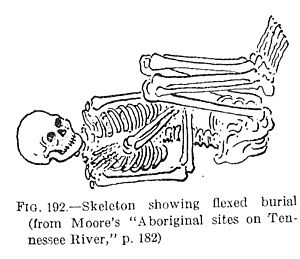
Mound No. 3 is a burial mound for the first people who lived at Fewkes. It is a low, oval mound on the southwest corner of the plaza. The mound is about 3 feet (0.9 meters) high and 100 feet (30 meters) by 110 feet (34 meters) across. Its edges are hard to see because it slopes gently into the ground.
It probably held 10-15 graves, but most were destroyed by people digging for treasures or by farming. Two graves were found that were different from typical burials in Middle Tennessee. Usually, bodies were buried lying flat. But here, the bodies were tightly bent. Their stone-slab graves were octagonal, hexagonal, or nearly round.
The first grave had missing top slabs and disturbed bones, likely by looters. It was octagonal and made of limestone. Items found with the body included five large shell beads and a clay pot. The second grave was similar in size and hexagonal. It also had been disturbed. Items found with this body included a small burial vase and a mussel shell, probably used as a spoon.
Mound No. 4: A Natural Hill?
Mound No. 4 is on the east side of the plaza. It is low and oblong, about 4 feet (1.2 meters) high, and 200 feet (61 meters) by 180 feet (55 meters) across. No signs of fire pits, pottery, or graves were found here. William Myer thought it might be a natural knoll (small hill). He believed its shape came from soil being taken to build Mound No. 1. Years of farming and weather have removed any signs of buildings that might have been on top.
Mound No. 5: Overlooking the River
Mound No. 5 is a small oval mound, 32 feet (9.8 meters) across and 3.5 feet (1.1 meters) high. It is about 300 feet (91 meters) north of Boiling Spring Academy, looking over the Little Harpeth River. No buildings or burials were found in this mound. However, broken animal bones and pottery pieces were scattered throughout the soil. Traces of a fire pit and two bone tools were also found.
Village Structures and Homes
Many saucer-like depressions were found around the north side of Mound No. 1 and in a nearby field. These are thought to be the remains of homes. Many more depressions were found west of Mound No. 2 and Mound No. 3. These buildings seem to have been built like the ceremonial buildings on the mounds, using cane mats and plastered walls.
Items found in these depressions include bear teeth, arrowheads, broken animal bones, and traces of plastered walls. Also found were stone disks (used in a game) and a supply of yellow ochre, likely used as body paint.
One circular depression was a smooth, hard-packed floor. In its center was an upright, stone-slab fire pit. One side of the pit was cut out for a child's grave. The child, about 12 years old, was buried against the slab, with its head resting in the bowl. Ashes were in the bowl and on the child's head, but the bones were not burned. Graves of two other children were also found in and below the floor.
Other Burials Found
Two burials were found about 100 feet (30 meters) southeast of Mound No. 3. The first was a woman buried on her right side, with her body loosely bent. No items were found with her. The second burial, next to the woman, was just a pile of bones. No items or stone box were found with these bones. We don't know if this person was related to the woman.
Other burials from the later group of people were found scattered around the site. Items found with these burials included conch shells, pottery, spearheads, and dice made from deer bones. A black stone statue of a female was also found.
Recent Excavations (1998)
In 1998, during a road construction project, the remains of at least 21 people were removed from the Fewkes site. Their burial items were also removed. These items included ceramic ear plugs, effigy jars (pots shaped like animals or people), projectile points (like arrowheads), a drilled dog tooth, and a bone awl (a tool for making holes). As of April 23, 2010, efforts are being made to rebury these remains, as their specific tribal connections are unknown.
Images for kids



